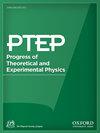热拉莫尔辐射
IF 8.3
4区 物理与天体物理
Q1 Physics and Astronomy
引用次数: 0
摘要
热辐射是从一个沿着特殊的、全局定义的连续加速轨迹运动的点电荷中产生的。计算完全是经典的(尽管出现了ℏ),但通过移动镜像模型,证明了它与量子场论的直接联系。我们给出了电子-镜像二元性的函数数学特性的精确公式,它允许我们在给定的直线轨迹上,在(1) 3+1 明考斯基时空中普通加速点电荷的经典辐射和(2) 1+1 平面时空中移动镜像的量子辐射之间进行映射。本文章由计算机程序翻译,如有差异,请以英文原文为准。
Thermal Larmor radiation
Thermal radiation is found from a moving point charge along a special, globally defined, continuous accelerated trajectory. The calculation is entirely classical (despite the appearance of ℏ) but is shown to have an immediate connection to quantum field theory via the moving mirror model. A precise recipe is given for the functional mathematical identity of the electron-mirror duality that allows one to map between (1) the classical radiation of an ordinary accelerating point charge in 3+1 Minkowski spacetime and (2) the quantum radiation of a moving mirror in 1+1 flat spacetime, for a given rectilinear trajectory.
求助全文
通过发布文献求助,成功后即可免费获取论文全文。
去求助
来源期刊

Progress of Theoretical and Experimental Physics
PHYSICS, MULTIDISCIPLINARY-PHYSICS, PARTICLES & FIELDS
CiteScore
12.00
自引率
5.70%
发文量
148
审稿时长
17 weeks
期刊介绍:
Progress of Theoretical and Experimental Physics (PTEP) is an international journal that publishes articles on theoretical and experimental physics. PTEP is a fully open access, online-only journal published by the Physical Society of Japan.
PTEP is the successor to Progress of Theoretical Physics (PTP), which terminated in December 2012 and merged into PTEP in January 2013.
PTP was founded in 1946 by Hideki Yukawa, the first Japanese Nobel Laureate. PTEP, the successor journal to PTP, has a broader scope than that of PTP covering both theoretical and experimental physics.
PTEP mainly covers areas including particles and fields, nuclear physics, astrophysics and cosmology, beam physics and instrumentation, and general and mathematical physics.
 求助内容:
求助内容: 应助结果提醒方式:
应助结果提醒方式:


